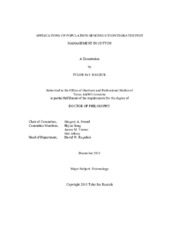| dc.description.abstract | In this dissertation, we used a population genomics approach to improve the
management of two insect cotton (Gossypium hirsutum L.) pests, the boll weevil,
Anthonomus grandis Boheman (Coleoptera: Curculionidae), and the cotton fleahopper,
Pseudatomoscelis seriatus (Reuter) (Hemiptera: Miridae). Despite the success of the
United States (US) Boll Weevil Eradication Program, the boll weevil remains a threat to
cotton production in the southern US, and is arguably the most important cotton pest in
Central and South America. The cotton fleahopper is a secondary pest of cotton whose
impact in the US has increased in the wake of improved management for other cotton
pest species. Management efforts for both species are complicated by a lack of detailed
knowledge of population genetic structure, and what little research there is has not taken
advantage of high-throughput sequencing technology. Here, we used double digest
restriction site-associated DNA sequencing (ddRADseq) to resolve the population
genomic structure of the boll weevil in the southern US, northern Mexico, and
Argentina, and of the cotton fleahopper in the Brazos Valley of Texas.
Our boll weevil research supported a two-form hypothesis of geographic variants
of boll weevil in North America wherein there is a western and eastern form, and
suggested that the two variants occur due to geographic isolation rather than host plant
association. Boll weevil collections from South America in Argentina were more closely
related to the eastern North American boll weevil lineage, but with levels of genetic
divergence consistent with isolation-by-distance. We also used a population genomics
approach to identify probable source populations for weevils re-infesting previously
eradicated areas in the US.
Our work on the cotton fleahopper revealed high gene flow among populations
collected from different host plants in the Brazos Valley. We identified one instance of
yearly turnover of local genotypes and one instance of monthly turnover in cotton,
indicating that population genomic structure may be labile to time. Our results also
identified a probable natural refuge that promotes year-end gene flow between genotypes
associated with cotton and those associated with alternative hosts. | en |


